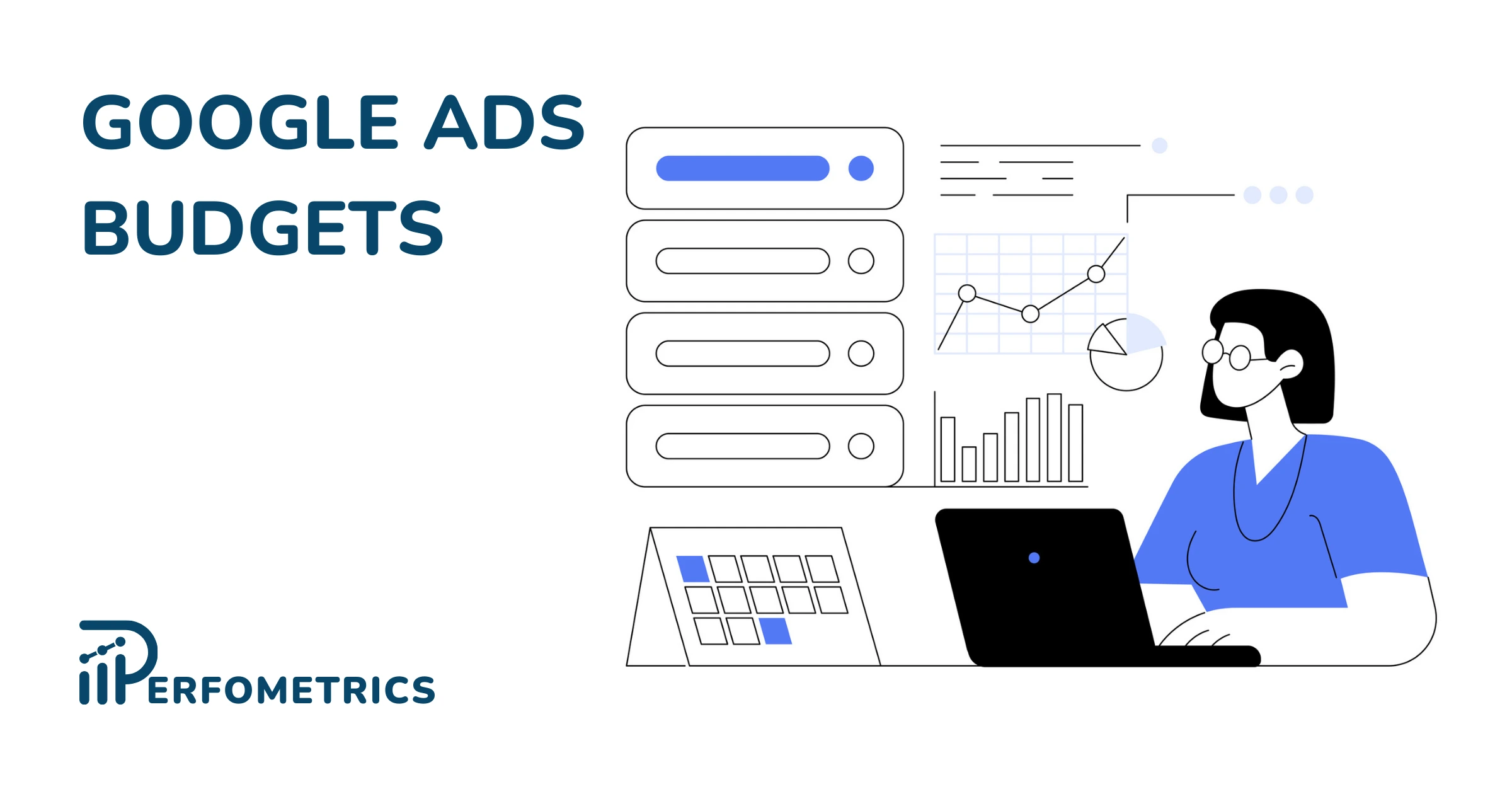Budget for Google Ads: Understanding the Costs [Full Guide]

How much to budget for Google Ads? This is a question regularly raised by new and seasoned advertisers alike. Budgeting for Google Ads is not a straightforward calculation. It’s rather a complex system of objectives, volumes, and strategies that determines the ultimate cost of each click.
To help you navigate this complex landscape, we’ve put together a comprehensive guide on Google Ads budgeting explaining how Google determines the cost of your ads and the various factors that impact your ad spend.
We’ll also provide practical tips and strategies for optimizing your ad campaigns, from selecting the right bidding strategy to creating compelling ad copy and improving your Quality Score.
What is a Google Ads Budget?
Simply put, a Google Ads budget refers to the amount of money you set aside for Google Ads campaigns. The budget determines how much you are willing to spend on clicks and impressions for your ads within a given timeframe.
There are two types of budgets you can set up in Google Ads:
- Daily budget: This is the amount of money you are willing to spend on your campaign each day. Google will attempt to distribute the daily budget throughout the day, but it may exceed the budget by no more than 2 times on any given day, depending on the traffic.
Note: Google advises if you wish to think in monthly terms, you should multiply your average daily budget by 30.4 (the average number of days per month)
- Shared campaign budget: This is the amount of money you are willing to spend across multiple campaigns. For instance, if you have allocated a shared daily budget of $100 across two campaigns and one campaign receives less traffic, spending only $30, the rest can be attributed to optimizing the other campaign. Shared budgets are specifically effective on seasonal campaigns that have a shared goal.
But how do you determine your budget? That’s the question we’ll help you answer by the end of this article. Keep on reading!
Understanding Google Ads Costs
Before you start planning your Google Ads budget, it’s important to first understand how Google Ads costs are determined.
There isn’t an exact formula that details this. Google Ads costs can vary widely depending on factors such as competition, ad quality, targeting options, and more. Here are some key things you should keep in mind when determining your Google Ads costs:
Cost Models
Google Ads offers different cost models, including cost-per-click (CPC) and cost-per-impression (CPM).
CPC is the most commonly used model. That’s because with CPC you only pay when someone clicks on your ad. With CPM you pay for every 1,000 ad impressions, regardless of clicks.
Factors that Influence Costs
Several factors can influence how much Google Ads cost, including competition, ad relevance, Quality Score, ad placement, targeting options, and more.
For example, highly competitive keywords will generally cost more to advertise on than less competitive ones. Meanwhile, if you have a higher Quality Score and more relevant ads, you may pay less than competitors with lower quality scores and less relevant ads.
Real-World Averages
The cost of advertising on Google Ads can vary widely depending on the industry, location, and current trends. For example, the average cost per click (CPC) for legal keywords can be over $10, while the average cost per click for beauty and personal care keywords can be as little as $1.11.
As you can see in the above image, another factor that will greatly influence your average CPC is the type of your Google Ads campaign. We notice that across all industries, Search campaigns have an average CPC of $2.76; that’s $0.41 for Display ads.
We notice the same thing with average CPM. Across platforms, Search ads have the highest average CPM of $38.40. Meanwhile, Google Display Ads have an average CPM of only $3.12.
Note: Once you launch your campaigns, you can monitor your average CPC under the “Avg. CPC” column in Campaigns.
As you can see, there are a number of factors at play that determine your Google Ads cost. It’s important to be well aware of them as different levels of CPC or CPM, volumes, competition, campaign type, etc, can affect how many impressions and/or clicks you can get for a given budget. Learning to balance these different points will help you in defining your budget and make the most of it.
Will Google Ads Go Over the Budget?
Google Ads may occasionally exceed your daily budget by up to 2x on days with higher clicks and conversions, potentially causing you to spend more than planned, which can be a concern.
However, over a month-long billing cycle, you won’t be charged more than your average daily budget would’ve allowed for over 30.4 days.
Setting a Budget for Google Ads
Setting a Google Ads budget involves considering your business goals, the costs involved in running a Google Ads campaign, and the amount of revenue or leads you can generate from your advertising spend. When setting a budget, you should consider the following:
- Estimate your conversion rate and cost per acquisition: What is the expected conversion rate for your ads, and how much does it cost to acquire a customer? Estimating these metrics can help you determine how much you should be willing to spend on advertising to achieve your goals. This is the ideal way to start thinking about your Google Ads budget. Start with the end result in mind: what would be a profitable cost per action for your business? From there, estimate how many visitors you need to bring to your page and how many of them need to convert.
- Research keyword costs and competition: Keyword research can help you understand the costs involved in running a Google Ads campaign, as well as the level of competition for your target keywords. Use tools such as Google Ads Keyword Planner to research the costs of keywords in your industry and location.
You can find the Keyword Planner under Tools & Settings > Planning > Keyword Planner. Select the location you want to show your ads in, and the ad language, and enter or import a list of keywords you want to target. Alternatively, you can use the Keyword Planner to discover new keywords.
Note: The Keyword Planner will show you the high and low CPC bid range for Search campaigns, which as we saw, can be different for other types of campaigns. Nevertheless, the tool can give you an idea of how much you need to budget for your campaign.
- Choose your maximum CPC: You can influence your budget using maximum CPC bids. This is the highest amount you are willing to pay for a click. This applies to manual bidding strategies and Max Clicks campaigns. With other types of bidding strategies, you can impact how much budget is used in any given campaign by adjusting the target CPA or target ROAS – a high value may spend more of your budget, but it also allows your campaign to reach more users; low targets restrict the available pool of users and hence, require less budget. This connects to properly estimating your conversion rates, profitability metrics, and ideal cost per action.
What is a Good Budget for Google Ads?
Well, as always, there is no golden number. You will have to consider all the above factors when determining your ad budget.
If you’re a beginner, the Google Ads Help Page has a tip for you: start small. Get started with a daily budget between $10 and $50. This will help you avoid overspending and allow you to optimize your campaigns before investing more.
If you already have historic campaign data, you can get started more confidently with a higher budget. Also, how much are you able to allocate to your advertising budget? This will depend on your overall marketing budget and objectives.
7 Strategies to Make the Most of Your Google Ads Budget
Alright, now let’s have a look at 7 strategies that can help you optimize your Google Ads budget
1. Optimize Your Quality Score
The Google Ads Quality Score is a diagnostic tool that helps evaluate the effectiveness of your ad quality when compared to that of your competitors. This tool measures your ad’s relevance and usefulness to users searching for your keyword on a scale of 1-10. A higher Quality Score indicates that your ad and landing page are more valuable than those of your competitors.
By utilizing the Quality Score diagnostic tool, you can pinpoint areas where improvements to your ads, landing pages, or keyword selection could be beneficial.
There are three key components of the Quality Score assessment:
- Expected Clickthrough Rate (CTR): This metric gauges the likelihood that your ad will be clicked when it appears.
- Ad Relevance: The relevance of your ad to a user’s search query is assessed to ensure that it aligns with their intent.
- Landing Page Experience: This factor evaluates the relevancy and usefulness of your landing page to users who click on your ad.
By focusing on improving these factors, you can increase your Quality Score and achieve better ad performance, which translates to more clicks, higher ad positions, lower CPC, and ultimately, better ROI.
2. Align Your Bidding Strategy with Your Goals
First, you need to clarify your campaign goals. Are you looking to drive traffic to your website, increase conversions, or raise brand awareness?
Then it’s important to have a deep understanding of the available Google Ads bidding strategies. There are various manual and automated bidding strategies available and each strategy works differently. It’s essential to know their benefits and limitations to make an informed decision.
Not sure which bidding strategy is right for you? Check out our article detailing every bidding strategy in Google Ads.
3. Use Negative Keywords
Negative keywords in Google Ads are essentially the opposite of regular keywords. They are terms that you specify to your ad platform that you don’t want your ads to be shown for. By using negative keywords, you can prevent your ads from being displayed to users who are unlikely to convert, reducing your ad spend and increasing your return on investment.
For example, if you’re selling high-end luxury watches, you might use negative keywords like “cheap”, “affordable” and “discount” to prevent your ads from being shown to users who are searching for less expensive options. This can help you target your ideal audience more effectively and avoid wasting ad spending on clicks that are unlikely to lead to a sale.
4. Bid Local
With geographic targeting, you can go as local as you need. This is especially useful if you want to implement a location-specific campaign, have a brick-and-mortar location, or wish to target specific groups of people.
Let’s take the example of a laundry service located in Miami. As you can see, the Search ads at the top of the page target the local keyword “laundry Miami”. This way they ensure that only interested users will click on their ads.
5. Balance Broad and Specific Targeting
So far we’ve covered two strategies that focus on narrowing your targeting to reach a relevant audience in Google Ads. However, you must strike a balance between casting a wide net to attract a large audience and focusing on a narrow audience to ensure relevance.
Broad targeting can be beneficial for raising brand awareness or promoting a new product or service. However, it can also end up being costly and may result in lower conversion rates if your ads are being shown to people who aren’t interested in what you have to offer. On the other hand, with specific targeting, you can ensure that your ads are being shown to people who are actively searching for or interested in what you have to offer. Yet, this may result in reaching a smaller pool of potential customers and limiting your brand exposure.
To strike the right balance, it’s important to consider the match types you use for your keywords, the audiences you target, and the placements where your ads will appear. Using a mix of broad match, phrase match, exact match, and negative keywords can help you reach a wider range of potential customers while still ensuring relevancy. Similarly, targeting a mix of broad and specific audiences can help you reach both a larger pool of potential customers and a more qualified audience.
When it comes to ad placements, it’s important to consider the relevance of the website or app where your ad will appear and the competition for that placement. For example, a highly relevant placement may generate more clicks and conversions, but it may also be more competitive and costly.
6. Optimize Your Ad Copy and Landing Pages
The goal here is to create ads and landing pages in Google Ads that are highly relevant to your target audience and that encourage them to take action, whether that’s making a purchase, filling out a form, or contacting you for more information. Improving the quality and relevance of your ads and landing pages can increase your ad rank and lower your cost per click.
To optimize your ad copy, you can use specific keywords, highlight unique selling points, and include calls to action that encourage users to take action.
For instance, this Display ad by Semrush has a clear message, an invitation to “Try for free”. After playing a video that highlights the key selling points of Semrush, the ad invites users to “Learn more” about activating the offer. As you can tell, the copy is simple and straightforward.
In addition to optimizing your ad copy, it’s also important to focus on optimizing your landing page. This is the page that users are directed to after clicking on your ad, and it’s important to ensure that it provides a seamless and engaging user experience that encourages users to take action.
If we continue with the Semrush example, we can see that the landing page follows these best practices.
The landing page has BIG WINS highlighted and in capitals – a clear benefit. The landing page follows the same line as the ad, providing that seamless experience. This can also be seen in the use of colors and the same CTA.
Scrolling down the page, the Semrush landing page includes success stories in the form of case studies, awards they’ve won, further explanations of what they have to offer, and a continuous message – Try it for free to achieve big wins.
7. Monitor and Adjust Your Budget
No matter whether you’re using automated or manual bidding, you should regularly monitor your campaigns and adjust their budget as needed.
Use Google Ads reporting tools to track key performance metrics such as click-through rate (CTR), conversion rate, and cost per acquisition (CPA). This will help you identify which campaigns and keywords are performing well and which ones are not.
Based on your performance data, set clear goals for what you want to achieve with your campaigns, such as a target CPA or a specific conversion rate. Use these goals to guide your budget adjustments.
Moreover, you can use bid adjustments in Google Ads to increase or decrease your bids for specific keywords or campaigns based on their performance. For example, if a campaign is performing well and generating a high ROI, consider increasing your bids to attract more clicks and conversions.
Our Final Thoughts
Hopefully, by now you’re feeling a bit more confident about navigating the murky waters of ad spend and cost-per-click.
Let’s recap some of the key takeaways from this article:
- Google Ads budget is the amount of money you allocate to your advertising campaigns on the platform.
- Understanding the costs associated with Google Ads can be tricky, but it’s crucial to optimizing your ad spend and getting the most bang for your buck.
- Setting a budget for Google Ads involves estimating your conversion rate and cost per acquisition, using keyword research tools, and working with max CPC.
- There’s no one-size-fits-all answer to what a good budget for Google Ads is; Start small to avoid overspending and adjust over time.
- To make the most of your Google Ads budget you must align your bidding strategy with your goals, improve your ad quality, target the right keywords, and regularly monitor and adjust your budget.
- Ultimately, success with Google Ads requires a combination of creativity, data-driven decision-making, and ongoing optimization to get the most out of your advertising budget.
By following these key takeaways, you’ll be able to make the most of your Google Ads budget and drive more traffic and conversions to your website.



